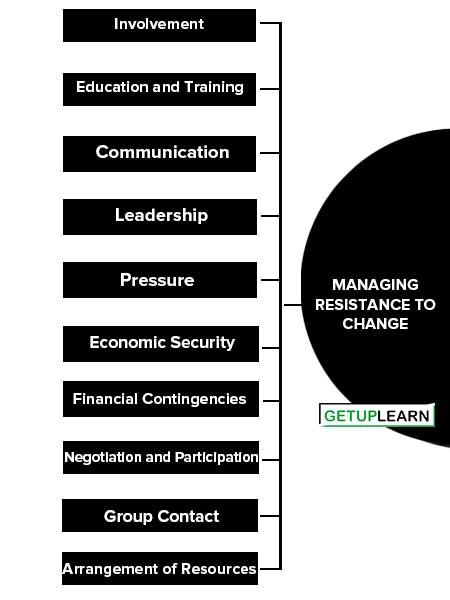In the management of change effectively, the managers face the problem of resistance to change. People tend to resist many types of changes because new habits or sacrifices are required. Similarly, social systems tend to resist change because of homeostasis.
Homeostasis implies the self-correcting characteristics of an organism to maintain equilibrium as a result of the change, that is, people act to establish a steady state of need fulfillment and to secure themselves from disturbance of that balance.
When a change is minor and within the scope of correcting program, adjustment is fairly routine, but when a change is major or unusual, more serious upsets may occur. This leads to the general proposition that people and their social systems will often resist change in organizations.
In fact, fear of change can be as significantly disrupting as change itself, because it produces identical symptoms. Before we trace out the reasons for resistance to change, let us discuss whether resistance is always bad as a generally perceived to be. In fact, there are two sides to resistance: as a cost and as a benefit.
Managing Resistance to Change
In order to implement the change successfully the expected opposition should be minimized. Efforts to minimize opposition should be both on the individual and collective level.
These are the two methods of managing resistance to change:
- Involvement
- Education and Training
- Communication
- Leadership
- Pressure
- Economic Security
- Negotiation and Participation
- Group Contact
- Arrangement of Resources
- Management of Cost of Change
- Proper Time of Change
- Slow Induction

At Individual Level
A change is likely to affect some people in some way if the resistance comes from the people on an individual level the problems can be solved at the same level, For this purpose, the following effects can be taken.
Involvement
On the individual level, the employees complain that they were not consulted at the time of taking the decision about the change. Therefore, they oppose the change, In order to solve this problem, the change agent should consult all those employees who are likely to be affected by the change.
Education and Training
The employees oppose the change because they are not aware of its advantages. Therefore, they should be informed about the concept of change from time to time. By doing so they get ready psychologically.
Communication
Sometimes the changes are opposed because the persons concerned are not given any information about the change. They should be enlightened about the necessity of change and its effects. In order to overcome this problem an effective system of communication should be adopted.
Leadership
The role of leadership in getting acceptance for a change is very important as a capable leader reinforces a climate of psychological support for change.
Pressure
Opposition to change should be handled in a human way, In case change is immediately needed and some particular employee opposes it unreasonably, pressure can be used in such a case.
Economic Security
Employees should be assured that the change will not harm them in any way economically. In case of any economic loss, they should be assured of full compensation.
At Group Level
Although agreement to a change can be obtained individually, it is more meaningful if it is done through the group.
Negotiation and Participation
Participation helps to give people involved in the organizational change a feeling of importance. It makes people feel that the organization needs their opinions and ideas and is unwilling to go ahead without taking them into account.
Group Contact
In order to end the possibility of opposition to change, consultations can be had with a group. During the course of the Discussion, they can be made to understand the causes that made the change imperative and how the various parties will be affected.
Other Measures
There are some other measures to reduce resistance to change such as:
Arrangement of Resources
The shortage of resources compels the top-level managers to oppose the change the managers should think of the change only after making arrangements for sufficient resources.
Management of Cost of Change
The top-level management should ensure that the loss likely to be suffered because of the change in permanent assets is compensated by implementing the program of change or otherwise the idea of introducing the change should be abandoned.
Proper Time of Change
The time of implementing the change deeply affects the resistance to change. If the organization is earning profits and the employees are not being given any bonus they will certainly resist change.
On the contrary, if the organization is earning good profits and employees are getting good bonuses along with other facilities, they will cooperate to change.
Slow Induction
The change should be gradually implemented in various stages, by doing so the employee gets mentally prepared for the change, and resistance to change is minimized.
FAQs About the Managing Resistance to Change
How to manage resistance to change?
These are the following techniques for managing resistance to change: Involvement, Education and Training, Communication, Leadership, Pressure, Economic Security, Negotiation and Participation, Group Contact, Arrangement of Resources, Management of Cost of Change, Proper Time of Change, and Slow Induction.
